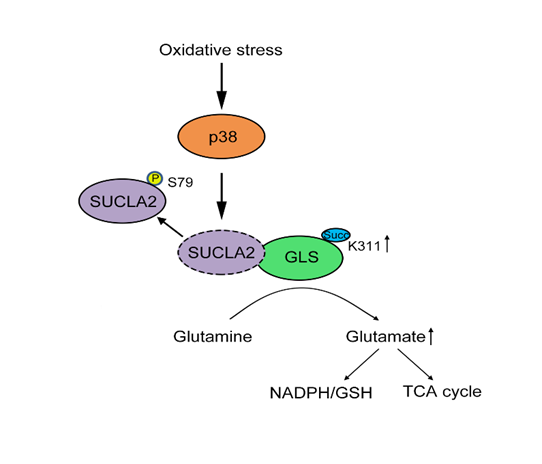Glutamine is the most abundant circulating amino acid in blood and muscle and is critical for many fundamental functions in cancer cells. Pancreatic ductal adenocarcinoma (PDAC) cells, for instance, utilize glutamine to support anabolic processes that fuel proliferation. Also, mitochondrial glutaminase (GLS) catalyzes the transformation of glutamine to glutamate, which is a key step for glutaminolysis. In this understanding, therapeutic approaches targeting GLS are in clinal trials to treat glutamine-addicted tumours with great significance.
Lysine succinylation, defined as a transfer of a succinyl group to a lysine residue, is a newly identified posttranslational modifications and occurs on a wide range of proteins. The research team led by Dr. LU Zhimin from the Zhejiang University Institute of Translational Medicine published an article entitled "SUCLA2-coupled regulation of GLS succinylation and activity counteracts oxidative stress in tumor cells" in Molecular Cell on May 15, 2021. This study found a new way to target GLS succinylation for cancer treatment.
In 2017, Dr. LU 's lab for the first time identified lysine acetyl-transferase 2A (KAT2A) can function as a protein succinyltransferase transferring the succinyl group from succinyl-CoA to histone H3 lysine 79 (H3K79), which is important for the regulation of gene expression in tumor cells (Nature, PMID: 29211711). However, how tumor cells dynamically regulate protein succinylation, thereby promoting tumor growth, remains unclear.
In the current report, Dr. LU 's group demonstrated that GLS is highly expressed in PDAC specimens with correspondingly upregulated glutamine dependence for PDAC cell proliferation. Importantly, succinyl-CoA caused GLS succinylation at evolutionarily conserved lysine311 (K311). GLS K311 succinylation promoted the conversion of GLS from monomer to active tetramer, thus improving its catalytic activity and enhancing glutaminolysis. Under the conditions without oxidative stress, mitochondrial SUCLA2 (succinate-CoA ligase ADP-forming subunit beta), an enzyme catalyzing the conversion of succinyl-CoA to succinate, associates with GLS, thereby reducing local succinate-CoA and suppressing GLS succinylation and activity. However, oxidative stress that happens unavoidably during tumor growth disrupted the association between GLS and SUCLA2 through p38-dependent SUCLA2 phosphorylation at S79, resulting in increased K311 succinylation. Activated GLS increases glutaminolysis to counteract oxidative-stress-induced ROS and apoptosis for supporting tumor growth.

Clinal PDAC sample analyses revealed that the levels of GLS K311 succinylation were positively associated with advanced stages of PDAC and poor prognosis for patients.
"These findings highlight the significance of the GLS succinylation in tumor growth and provide a strategy for development of drugs targeting tumor glutamine metabolism" LU Zhimin said.
Source: School of Medicine






